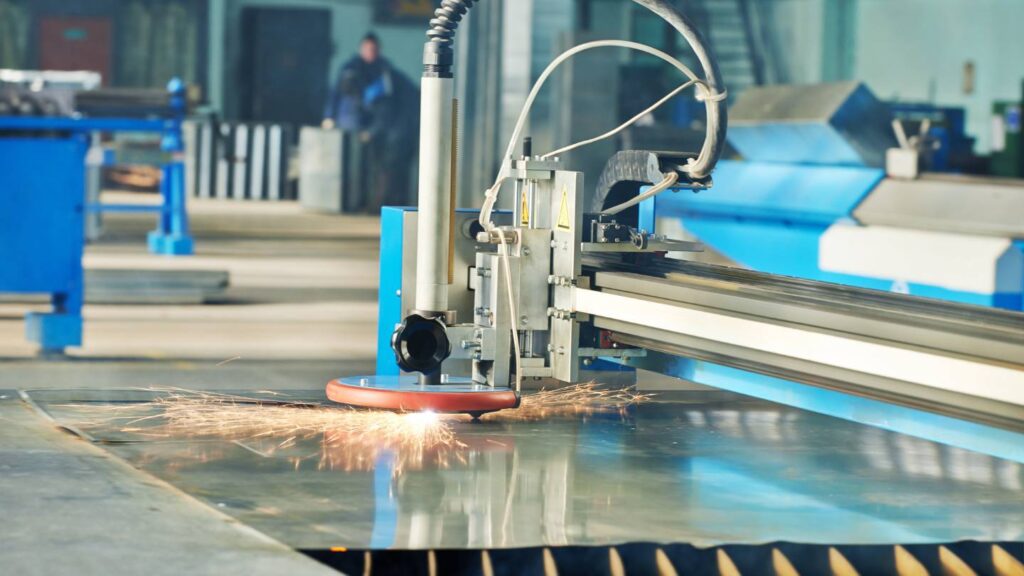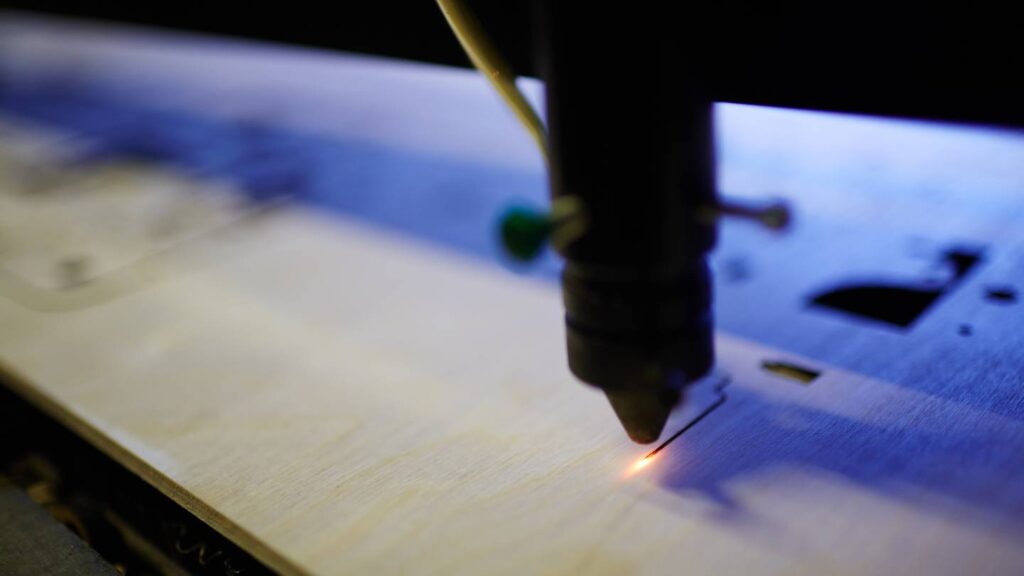Laser cutting is a vital technology in metal fabrication, offering unmatched precision and versatility. However, achieving high accuracy requires carefully balancing various factors, from machine settings to material properties.
In this comprehensive guide, we’ll explore actionable tips for improving laser cutting accuracy, ensuring that your processes yield the best possible results in quality and efficiency.
Let’s get straight to the point
Enhancing laser cutting accuracy in metal fabrication involves optimising cutting speed, understanding material properties, and ensuring regular machine maintenance. Key factors include balancing speed with precision, adjusting settings based on material thickness and reflectivity, and maintaining proper beam focus and nozzle distance.
Regular cleaning, calibration, and mechanical inspections of the laser cutter are crucial for consistent accuracy. Additionally, stable environmental conditions, such as vibration control, temperature regulation, and the appropriate use of gas assist, play significant roles in achieving clean, precise cuts.

The Critical Role of Cutting Speed in Laser Accuracy
Cutting speed is one of the most significant factors affecting the accuracy of laser cuts and the overall production time. The speed at which the laser moves across the material can profoundly impact the quality of the cuts produced.
- High-Speed Cutting: Production time is reduced when the laser cutting process is executed at high speeds. This is particularly advantageous for large-scale manufacturing operations where efficiency is paramount. However, there is a trade-off: increased speed can lead to less precise cuts, especially in complex designs or when cutting thicker materials. Fast cutting may result in rough edges, incomplete cuts, or deviations from the desired dimensions due to insufficient time for the laser to fully penetrate the material.
- Low-Speed Cutting: Conversely, slowing down the cutting speed allows the laser to maintain consistent energy delivery to the material, leading to more precise and cleaner cuts. This is especially important when working with intricate designs or thicker materials, where precision is more critical than speed. While this approach increases production time, the enhanced accuracy can significantly reduce the need for post-processing, ultimately saving time in the long run.
- Balancing Speed and Accuracy: The key to optimising laser cutting accuracy is finding the right balance between speed and precision. Adjustments to laser power, material thickness, and cutting speed should be made based on the specific requirements of the job. For example, fine-tuning these settings for different materials or designs can help achieve the desired level of accuracy without compromising production efficiency.
Material Properties and Their Impact on Cutting Precision
The properties of the material being cut play a crucial role in determining the accuracy of laser cutting. Different materials respond to laser cutting in various ways, and understanding these responses is essential for optimising the cutting process.
- Material Thickness: The thickness of the material directly influences the laser’s ability to cut through it accurately. Thicker materials require slower cutting speeds and higher laser power to ensure that the laser beam fully penetrates the material. If the cutting speed is too fast or the power too low, the laser may not cut through the material completely, leading to incomplete or inaccurate cuts.
- Material Reflectivity and Conductivity: Materials with high reflectivity, such as aluminium and copper, can pose challenges for laser cutting. The laser beam may reflect off the surface, reducing the energy absorbed by the material and affecting the quality of the cut. Special coatings or adjustments to the laser’s wavelength might be necessary to improve cutting efficiency.
- Thermal Conductivity: Materials with high thermal conductivity, such as metals, dissipate heat quickly. This can affect the cutting process, as the heat generated by the laser may spread away from the cutting area, leading to less precise cuts. These materials often require lower cutting speeds and higher power settings to maintain cutting accuracy.
- Test Cuts for Optimisations: To achieve the best possible results, it’s advisable to perform test cuts on sample pieces of the material. This allows you to fine-tune the laser settings—such as power, speed, and focal length—based on the specific properties of the material. You can determine the optimal parameters for achieving precise cuts by experimenting with different settings.
The Importance of Regular Machine Maintenance and Calibration
Maintaining the laser cutting machine in peak condition ensures consistent accuracy. Over time, various machine components can drift out of alignment or become dirty, leading to a decline in performance.
- Cleaning Optical Components: Regular cleaning of optical components, including lenses and mirrors, is crucial. Dust, debris, or residue on these components can scatter the laser beam, reducing its focus and leading to less precise cuts. A routine cleaning schedule should be established to ensure these components are contaminant-free.
- Beam Alignment: The alignment of the laser beam is another critical factor that affects cutting accuracy. Even slight misalignments can cause the laser to deviate from its intended path, leading to inaccuracies in the cut. Regular checks and adjustments to the beam alignment are necessary to maintain precision, particularly after significant machine use or any maintenance work.
- Calibration of Power Settings: The laser’s power output can drift over time, especially if the machine is used frequently. It’s important to regularly calibrate the power settings to ensure the laser delivers the correct amount of energy to the material. Incorrect power settings can result in incomplete cuts (if the power is too low) or excessive material burning (if the power is too high).
- Lubrication and Mechanical Inspections: The mechanical components of the laser cutter, such as the motors and guides, should be regularly lubricated to ensure smooth operation. Additionally, regular inspections for wear and tear on mechanical parts can help prevent mechanical failures that could affect cutting accuracy.
Optimising Beam Focus and Nozzle Position
The focus of the laser beam and the position of the nozzle relative to the material are crucial determinants of cutting accuracy. Proper adjustments in these areas can significantly improve the quality of cuts.
- Adjusting the Focal Length: The focal length of the laser beam should be adjusted based on the thickness of the cut material. For thinner materials, a shorter focal length is often ideal, allowing the beam to focus more precisely on the material’s surface, leading to cleaner cuts. A longer focal length may be necessary for thicker materials to ensure that the beam penetrates deeper.
- Consistent Nozzle Distance: Maintaining a consistent distance between the laser nozzle and the material surface is critical for achieving uniform cuts. Variations in this distance can cause inconsistencies in the cut depth and width. Automatic height adjustment features in some laser cutting machines can help maintain this consistency, but manual checks and adjustments are still advisable.
- Adaptive Optics: Adaptive optics can be employed for complex cutting tasks requiring high precision. These systems allow for real-time adjustments to the laser beam’s focus, compensating for any changes in material thickness or positioning during the cutting process. This ensures that the laser maintains optimal focus and cutting conditions throughout the operation.
Ensuring Environmental and Mechanical Stability
The environment in which the laser cutter operates can also impact the accuracy of the cuts. External factors such as vibrations, temperature fluctuations, and air quality can all contribute to variations in cutting precision.
- Stable Workbench: The stability of the workbench or cutting table is paramount, especially for tasks that demand high precision. Any vibrations or movements during the cutting process can cause the laser to deviate from its intended path, resulting in inaccurate cuts. A sturdy, well-leveled workbench can prevent these issues.
- Temperature Control: Environmental fluctuations can affect the laser’s performance, particularly in beam stability and material response. Maintaining a stable temperature in the cutting area can help ensure consistent cutting results. Environmental control systems may be necessary for highly sensitive materials or precision tasks.
- Air Quality: The air quality in the cutting environment can also affect the process. Dust and particles in the air can settle on the material or the machine’s optical components, interfering with the laser beam. Proper ventilation and air filtration systems should be in place to maintain a clean working environment.

Utilising Gas Assist for Cleaner Cuts
Gas assist is an integral part of the laser cutting process, significantly enhancing the quality of cuts and extending the life of the machine.
- Purpose of Gas Assist: Gas Assist helps remove molten material and debris from the cutting area, preventing it from re-solidifying and causing imperfections in the cut. It also helps cool the material and reduce the heat-affected zone (HAZ), leading to cleaner, more precise cuts.
- Choosing the Right Assist Gas: The choice of assist gas depends on the material being cut and the desired quality of the cut. Common assist gases include oxygen, nitrogen, and air. Oxygen is often used for cutting thicker metals, as it promotes oxidation, which helps in the cutting process. Nitrogen, on the other hand, is used when a clean, oxide-free edge is required, such as in stainless steel cutting.
- Nozzle Diameter: The diameter of the gas assist nozzle should be selected based on the material’s thickness and the required cutting quality. Smaller nozzle diameters provide finer cuts, while larger diameters allow higher cutting speeds and better debris clearance.
Fine-Tuning Power and Speed Settings
To achieve optimal cutting accuracy, the laser’s power and speed settings must be fine-tuned based on the specific material and thickness.
- Experimentation and Testing: Experimenting with different power and speed combinations on sample materials is the best way to find the ideal settings for each job. The goal is to find a balance where the laser cuts cleanly through the material without excessive burning or melting.
- Pre- and Post-Heating Techniques: In some cases, pre-heating the material before cutting can improve the laser’s ability to penetrate thicker materials, leading to cleaner cuts. Post-heating can also reduce residual stress in the cut areas, minimising the risk of distortion.
Conclusion
Achieving high accuracy in laser cutting for metal fabrication involves a meticulous approach to managing various factors, including cutting speed, material properties, machine maintenance, environmental conditions, and fine-tuning of settings. By understanding and optimising these elements, you can significantly enhance the precision and quality of your laser-cutting operations.
Regular maintenance, proper setup, and continuous testing are key to maintaining high accuracy standards. Implementing these tips will improve the quality of your cuts and increase the efficiency and reliability of your production processes.

